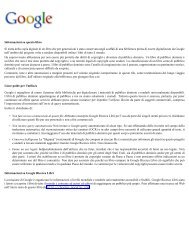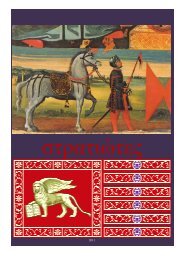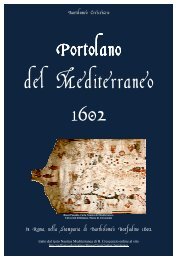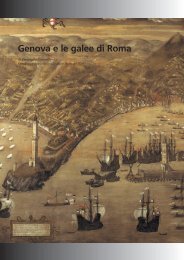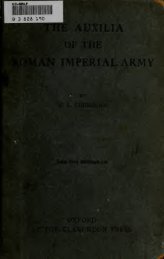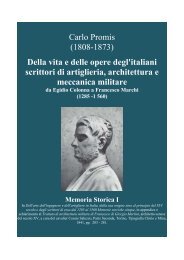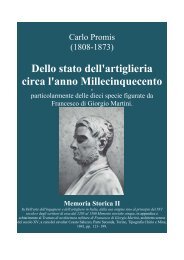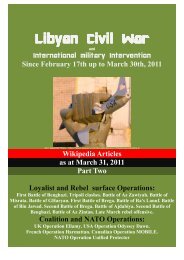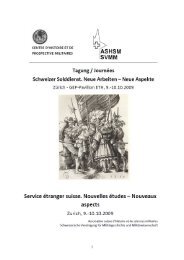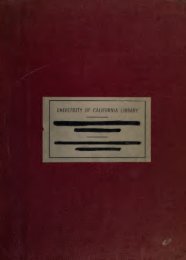48 SMITHSONIAN STUDIES IN HISTORY AND TECHNOLOGYTHE FORAGE CAPThe forage cap adopted by the Marcy Board waslittle more than a continuation of the nonregulation"chasseur" or "McClellan" pattern so popularwith officers during and after the Civil War andwhich hatters had been advertising during the late1860s.'°' Indeed, the 1872 regulations used the term"chasseur." It is apparent that the members of theboard personally favored the model for there is noevidence that they paid attention to the commentsregarding it in the Woodhull Report as they didin relation to the campaign hat."^ Woodhull hadwritten pointedly of the cap's shortcomings, its"want of grip . . its want of warmth, the deficientprotection it afford[ed] the face and neck againstsun and rain . . . and . . the absence of ventilation."The Report also noted the difficulty ofcleaning it and had suggested the adoption of adetachable flap for the rear and sides to be usedin cold weather.'"^ The regulations read:For General Officers: Of dark blue cloth. Chasseur pattern,with black velvet band and badge in front.For all other Commissioned Officers: Of dark blue cloth.Chasseur pattern, with badge of corps or regiment in front,top of badge to be even with top of cap, and according topattern in Quartermaster General's Office.For all Enlisted Men: Of plain blue cloth, same patternas for officers, with badge of corps or letter of company ofyellow metal worn in front as for officers.Warnock & Co. made the pattern or patterns forthe board and the first contract was let with Bent& Bush of Boston oh 30 October for 28,000 caps at.f 1.071/2 each.'*" The allowance was set at one capand cover per year of enlistment at a price to theindividual of $1.08 for the cap, $.21 for the cover,and $.03 for the insignia.'" The first issue was orderedin February 1873.'*'The first real description of the cap was of thatfor officers. Indeed, it had been the wide divergencefrom standard of the officers' forage caps thatin large part triggered the description publishedin the 1876 Annual Report of the QuartermasterGeneral.'**FORAGE-CAP.Chasseur pattern, as shown in accompanying plates numbered3 and 4; of indigo-blue cloth; 3 inches high in front;3/a inches high on sides; 6 inches from edge of crown tobottom of band at back; crown 5 inches in diameter;depth of band about 1^4 inches; gilt side or chin-strap buttons,vest size, according to arm of service; patent-leatherchin-strap Ys of an inch wide; patent-leather vizor unbound;japanned or goat-skin sweat-leather, silk lining; embroideredbadge of arm or corps in front; bottom of badgeto be even with top of chin-strap.For general officers, the band of cap to be of blackvelvet.FORAGE-CAP BADGES.For general officers.—A gold-embroidered wreath on darkbluecloth ground, encircling the letters U.S. in silver, oldEnglish characters.For officers of the general staff and staff corps.^Same asfor general officers, with the exception of those for ordnance-officers,which will have a gold-embroidered shell andflame on dark-blue cloth ground.For officers of engineers.—A gold-embroidered wreath oflaurel and palm, encircling a silver-turreted castle on darkbluecloth ground.For officers of cavalry.—Two gold-embroidered sabres,crossed, edges upward, on dark-blue cloth ground, with thenumber of the regiment, in silver, in the upper angle.For officers of artillery.—Two gold-embroidered cannons,crossed, on dark-blue cloth ground, with the number of theregiment, in silver, at the intersection of the cross-cannon.For officers of infantry.—Two gold-embroidered rifles,without bayonets, barrels upward, on dark-blue clothground, with the number of the regiment, in silver, in theupper angle.Even with these specifications, the officers' modelcontinued to diverge from the standard seeminglyat the whim of the individual concerned, the trendalways being toward a lower crown. As late as 1892the Quartermaster General was stating in his annualreport that as the crown of the forage caphad gradually been lowered to the extent that itwas difficult to keep on the head, steps had beentaken to return to the original model, includingspecifications and new samples. This statementcould hardly have referred to the enlisted model,unless the soldiers were buying them from civiliansources, as a check of those specimens bearing contractdates in the late 1880s and early 1890s showsthem to conform to the 1876 specifications as toheight of crown.'*"Quartermaster Specification No. 5, adopted 31May 1876, gave the first detailed description of theenlisted cap:WAR DEPARTMENTQUARTERMASTER GENERAL'S OFFICEspecifications for Forage Caps.Made of best wool-dyed indigo-blue cloth. Band aboutone and one-fourth (1 }4) inch wide, strengthened by a strip
NUMBER 3049of strong split-leather of the same width, sewed in betweenllic cloth and the sweat-leather. The front rises straight andvertical one and one-half (I/2) to one and five-eighths(lYo) inch above the band, sides straight and slightly convergingtoward the crown. The back, about live (5) incheslong, rises from the band forward at an angle of 45 degrees,slightly convex.The crown is circular, about four and three-fourths (4%)inches in diameter, made upon strong "tarred board."The shape of the cap would thus give an incline to thecrown of one (1) to one and one-fourth (I'/i) inch fromrear to front.A straight horizontal vizor of patent enameled leather,about three-sixteenths (%o) of an inch thick, shaped as describedfor dress-caps. A small brass regulation button oneach side, immediately behind the end of the vizor, for chinstrap.The latter is made in two parts, of fine enameled leatherabout one-half (/a) inch wide, each part about nine (9)inches long, and arranged, as on dress-cap, to be lengthenedand shortened at will.Sweat-leather of Belgium leather, one and one-half (1 /a)inch wide.Lining of glazed muslin, fastened by its lower edge onlyto the inner stiffening of the band, the upper edge gatheredwith strong thread.Adopted May 31, 1876.M. C. MEIGS,Quartermaster General,Bvt. Major General, U.S.A.""Between 1876 and 1895 when another pattern wasadopted, the specifications were changed somewhat,but to no appreciable degree.""'Late in 1883 the Headquarters of the <strong>Army</strong> orderedthe black leather chin strap on officers' capsreplaced by a two-strand "cap-strap' of gold onsilver cord.'*^ It seems probable that this ordermerely legitimatized what had been in being forsome time, for of the nine officers' caps examined,all had the gold "cap-strap" rather than the leatherchin strap, one of them having belonged to anofficer '*' who left the <strong>Army</strong> over two years beforethe order was issued, and all show evidence of considerablewear. There was some minor confusionas to the style of these cords, some terminating atthe chin strap buttons in a figure eight, others havinga gold thread "slide" or "turk's head" on eitherside. In 1884 the Quartermaster General furnishedthe <strong>United</strong> <strong>States</strong> <strong>Army</strong> and Navy Journal withspecifications calling for the gold "slides,'' one-halfinch long and of three-eighths inch diameter.'*^A number of enlisted models of the cap havebeen examined and all follow the specificationswithin allowable tolerances (Figure 34). The officers'models are something again. With the exceptionof that worn by Maj. Gen. Winfield ScottHancock (Figure 35a) all are lower in the frontthan called for, several by as much as 50 percent(Figure 35b), even when they can be dated laterthan the officers' specifications of 1876.The regulations were more specific as to the insigniafor the forage cap than they had been inthe case of the dress cap, although the problem ofsize was not settled until 1877. Caps of generalofficers and officers of the general staff and staffcorps (all of whom were authorized the chapeaurather than the dress cap) were to carry a gold embroideredwreath encircling the silver letters "US"in Old English, except those of ordnance officers,which would carry a gold embroidered shell andflame, and of engineer officers, which were to beara silver turreted castle within an embroideredwreath of laurel and palm.'"" Cavalry officers wereto wear gold embroidered crossed sabers, edges up,with the number of the regiment in silver in theupper angle; artillery gold embroidered crossedcannon with the regimental number in silver "atthe intersection;" "" and for infantry, a gold embroideredbugle with the regimental number insilver in the "bend" or loop. Enlisted arm andbranch insignia followed those prescribed for thedress cap in design and dimensions.'"' In 1882 thebadge of hospital stewards was changed from thewreath and "US" to the wreath and caduceus.'"* Ayear later, officers of the Adjutant General's Departmentwere authorized to wear a "solid silvershield bearing thirteen stars'' within a gold embroideredwreath, and the following year signalcorps officers were authorized a gold embroideredwreath encircling two crossed signal flags with avertical burning torch at the intersection."* In1885 signal corps enlisted men were authorized thecrossed signal flags and torch (what they wore beforethat date is unstated) and the classification ofmusicians was clarified somewhat with "band"musicians being authorized a lyre in white metal,"field" musicians continuing with the bugle or"looped horn" with the number of the regiment inthe loop and the company letter above, the cavalrytrumpeters being authorized the cavalry crossedsabers with the number above and the letter below.The dimensions of the bugle and crossed sabers apparentlywere to be the same as those given in the1877 specifications, but nowhere were the dimensionsof the lyre and signal flags given in detail.At the same time, post quartermaster sergeants
- Page 1:
• ^ - :lP-'L^ry\'^ ^iT
- Page 4 and 5:
ABSTRACTHowell, Edgar M. United Sta
- Page 7 and 8: ContentsPagePrefaceiiiThe 1855 Cava
- Page 9 and 10: United States Army Headgear 1855-19
- Page 11 and 12: NUMBER 30report, stated: "The hat p
- Page 13 and 14: NUMBER 30acorns %g inches long and
- Page 15 and 16: NUMBER 30the pattern." The rate of
- Page 17 and 18: NUMBER 30FIGURE 3.—1858 Army hat.
- Page 19 and 20: NUMBER 3011model, number 60 in the
- Page 21 and 22: NUMBER 30 13"the desired modificati
- Page 23 and 24: NUMBER 30 15the sun in the top. The
- Page 25 and 26: NUMBER 30 17FIGURE 8.—1858 forage
- Page 27 and 28: NUMBER 30 19Hardtack and Coffee, ca
- Page 29 and 30: NUMBER 3021FIGURE 11.—a, Brigadie
- Page 31 and 32: NUMBER 30 23short "shell" jacket "f
- Page 33 and 34: NUMBER 30 26broad, securely soldere
- Page 35 and 36: NUMBER 30 27worn in the picture wer
- Page 37 and 38: NUMBER 30 29This communication elic
- Page 39 and 40: NUMBER 30 31FIGURE 17.—"The [Scot
- Page 41 and 42: NUMBER 30 33time for issue in the c
- Page 43 and 44: NUMBER 30 35be at too great a dista
- Page 45 and 46: NUMBER 3037half (5/2) part of washb
- Page 47 and 48: NUMBER 30 39trimmings for all enlis
- Page 49 and 50: NUMBER 30 41ing the upper space for
- Page 51 and 52: NUMBER 30rear one to a correspondin
- Page 53 and 54: NUMBER 30 46FIGURE 29.—1872 enlis
- Page 55: NUMBER 3047FIGURE 32.—^The Bent &
- Page 59 and 60: NUMBER 30 51''""MttfenFIGURE 35.—
- Page 61 and 62: NUMBER 30 53(which he thought might
- Page 63 and 64: NUMBER 30 55FIGURE 38.—Captain Be
- Page 65 and 66: NUMBER 30 57campaign hat for the Ar
- Page 67 and 68: NUMBER 30 59salvage something from
- Page 69 and 70: NUMBER 30 61hat. In June 1899 the P
- Page 71 and 72: NUMBER 3063the left side, pass diag
- Page 73 and 74: NUMBER 30 65.LJU^.."*^..FIGURE 44.
- Page 75 and 76: NUMBER 30 67to be sent to Washingto
- Page 77 and 78: NUMBER 30 69with brass sliding-buck
- Page 79 and 80: NUMBER 30 71FIGURE 48.—Officers'
- Page 81 and 82: NUMBER 3073The adoption of the whit
- Page 83 and 84: NUMBER 3075i >•^\Wiii I ifiiiniim
- Page 85 and 86: NUMBER 30this last model made no pr
- Page 87 and 88: NUMBER 30 79WAR DEPARTMENT,QUARTERM
- Page 89 and 90: NUMBER 3081FIGURE 58.—1864 chapea
- Page 91 and 92: NUMBER 30geon 1880 and Surgeon Gene
- Page 93 and 94: NUMBER 3085FIGURE 63.—1895 forage
- Page 95 and 96: NUMBER 30 87of not less than 9.24 g
- Page 97 and 98: AppendixMAKERS OF HEADGEARThe chron
- Page 99 and 100: List of AbbreviationsAAGAAQMAGAGOAQ
- Page 101 and 102: NUMBER 3093all OQMG, LS, Clothing,
- Page 103 and 104: NUMBER 30 95"Jesup to Thomas, 8 Dec
- Page 105 and 106: NUMBER 3097OQMG, Reg. LR, Clothing,
- Page 107 and 108:
NUMBER 30 99October of 1870. See Me
- Page 109 and 110:
NUMBER 30 101'"* See above, pp. 35-
- Page 111 and 112:
NUMBER 30 103Monroe, Va., in 1878.
- Page 113 and 114:
NUMBER 30 105""Endorsement, 24 May
- Page 115 and 116:
ReferencesThe bulk of the source ma
- Page 117:
M MBIiR 30 10910, No. 355-10, 19 Se



